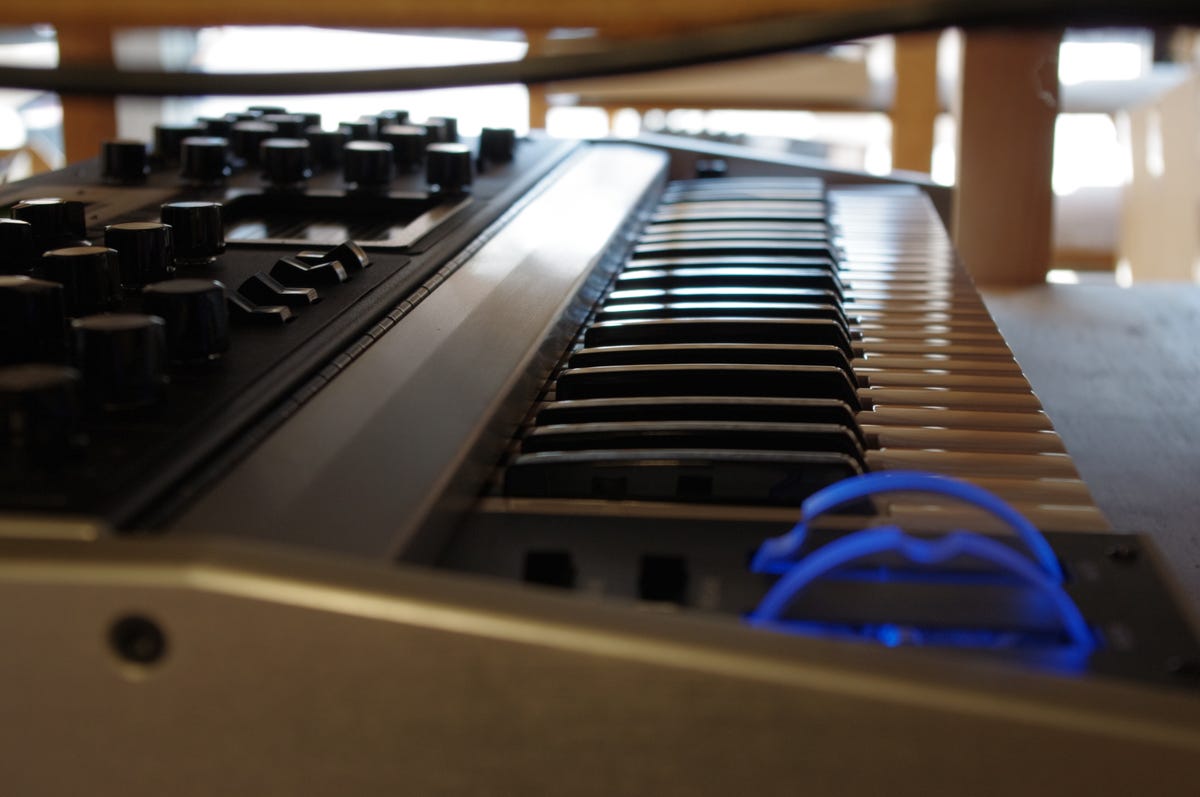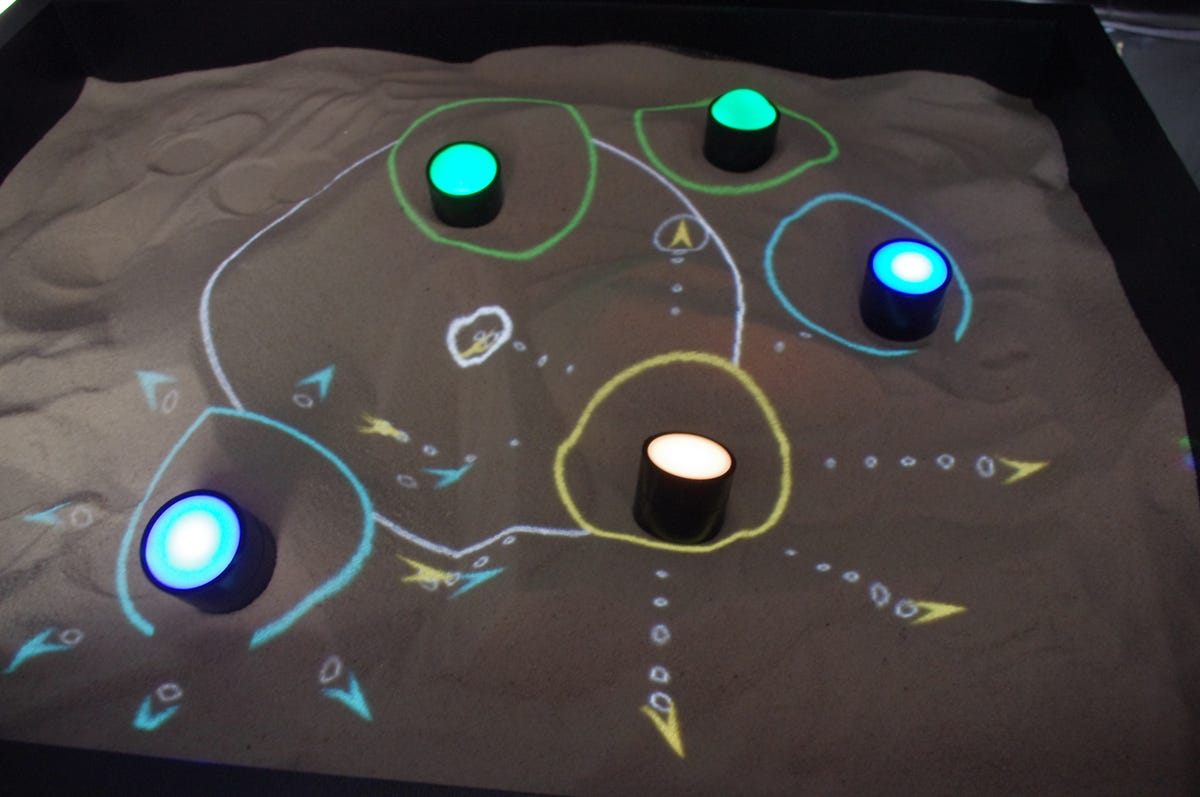Fur-covered theremins and other Moog marvels (pictures)
Moogfest -- a celebration of the electronic music and culture inspired by the inventor of the world's first modular synthesizer -- just buzzed through North Carolina. Here are some of the Moogy, groovy highlights.

Burning in
It's been 50 years since the world's first modular synthesizer hit the market. Moog Music in Asheville, N.C., celebrates the evolution of the sound-bending instrument with a regular event called Moogfest. Here are some highlights from this year's recent festival of music, ideas, and art.
A Moog synthesizer sits on a simple wooden rack, where it's being "burned in." All Moog instruments are completely hand-assembled at the one-and-only factory in Asheville, using as many local materials as possible. They're left running for a period of 48 hours to make sure "nothing bursts into smoke," according to a Moog representative.
See related article: Grooving and geeking at the Moogfest music spree
Tuning up
After the burning-in process, the Moog synthesizers are moved to a sound booth where they're individually hand-tuned by an employee. Because Moog instruments are analog and not digital, there can be slight distortions from one instrument to the next. The goal at this stage of the process is to keep those to a minimum.
See related article: Grooving and geeking at the Moogfest music spree
Magno-Guitar
This is the Moog Guitar, an instrument that can produce infinite sustain from one pluck of a string because it uses an electromagnetic field to manipulate the string's vibration. Our tour guide through the Moog factory says the company often hears from musicians that the Moog Guitar is their "secret weapon," helping them regularly secure gigs.
If you're thinking of getting one, though, you'll have to search eBay, as the factory is no longer making them. According to the Moog rep, when you have a staff of under 50 people, "you have to make hard choices" about what you can produce.
See related article: Grooving and geeking at the Moogfest music spree
Fuzzy theremin
In the lobby of one of the theaters that served as a venue for Moogfest 2014 were a series of theremins that could be played by the public, including this fur-capped version.
The first theremin was invented in 1919 by a Russian physicist named Leon Theremin. The instrument produces that classic warped violin "spaceship sound" popularized in sci-fi and horror films of the 1950s and '60s. It's unique in that it's played without being touched. You simply move one hand toward and away from the vertical antenna to control pitch and the other hand toward and away from the horizontal antenna to control volume.
Each afternoon at Moogfest, theremin wiz Dorit Chrysler gave a brief concert demonstrating the hauntingly beautiful compositions that can be made with the quirky instrument.
See related article: Grooving and geeking at the Moogfest music spree

Sand Noise Device
One of the standout projects of the Moogfest art installation series, this Sand Noise Device (SND) was invented by a team of students from the California State University system. It consists of a box filled with sand and several movable self-contained cylinders that glow with different colored lights. A white light pulse, triggered by sound, ripples out from the center of the sandbox at regular intervals. When the white ripple hits the cylinders, it causes them to release a series of icons that look like mini spaceships. The movement of the spaceship icons is dependent on the grade of the sand.
Both the sand and the cylinders can be completely repositioned, so you could make mini sand mounts that would trap the flying triangles of light until they lost steam and exploded (bwahahaha).
A Micosoft Kinect is suspended above the box and senses the position of the sand and the glowing cylinders, while an overhead projector handles the beaming of the ripple and icons.
See related article: Grooving and geeking at the Moogfest music spree
Beat doctors
In addition to plenty of hands-on devices that let festivalgoers make their own music, there were also a lot of performers filling halls big and small with their sounds. When the Pet Shop Boys took the stage, their team of musical technicians in Day-Glo orange lab coats kept things running smoothly from their soundboards and computer stations in the audience. Other main acts included Kraftwerk, which used the giant 3D projection screen behind them to beam images out to the polarized-glass-wearing crowd, and Chic, fronted by Nile Rodgers, who recently won a Grammy for his work on Daft Punk's latest album, "Random Access Memories."
See related article: Grooving and geeking at the Moogfest music spree
Bass projector
This device, another one of the art installations, beamed lasers at mirrors mounted on top of a speaker. A deeply resonant sound was fed through the speaker from an attached keyboard that could be operated by festival attendees. The sound made the speaker bounce, causing the laser light that was reflected onto the ceiling to jiggle around and make interesting patterns -- in effect, letting you "see" the music.
"The project is a good illustration of the scientific principals of cymatics, where sound vibrations are translated through a specifically visual medium," said a statement about the installation created by "="" the="" music.="" "the="" project="" is="" a="" good="" illustration="" of="" scientific="" principals="" cymatics,="" where="" sound="" vibrations="" are="" translated="" through="" specifically="" visual="" medium"="" said="" statement="" about="" installation="" created="" by="" nick="" zammuto."="" rel="nofollow">Nick Zammuto.
See related article: Grooving and geeking at the Moogfest music spree
Monster Moog
On the Friday of the festival last week, Moog Music unveiled a monstrous musical machine. It was a reproduction of Keith Emmerson's Moog Modular that he used to help create Emerson, Lake & Palmer's signature sound.
It took the team at Moog three years to create the machine using "the original documentation as well as circuit board and art files for nearly every original Moog module" according to a statement.
"The modules in the new Emerson Moog Modular System are built just as the originals were, by hand-stuffing and hand-soldering components to circuit boards, and using traditional wiring methods," the statement continues. "Even the front panels are photo-etched aluminum (a rare process now), which is the classic and durable look of vintage Moog modules."
The device was released on the 50th anniversary of the introduction of the original Moog Modular -- widely regarded as the first-ever voltage-controlled synthesizer.
See related article: Grooving and geeking at the Moogfest music spree

